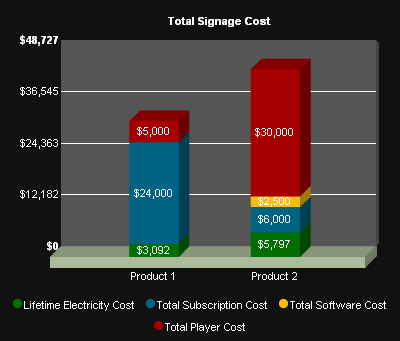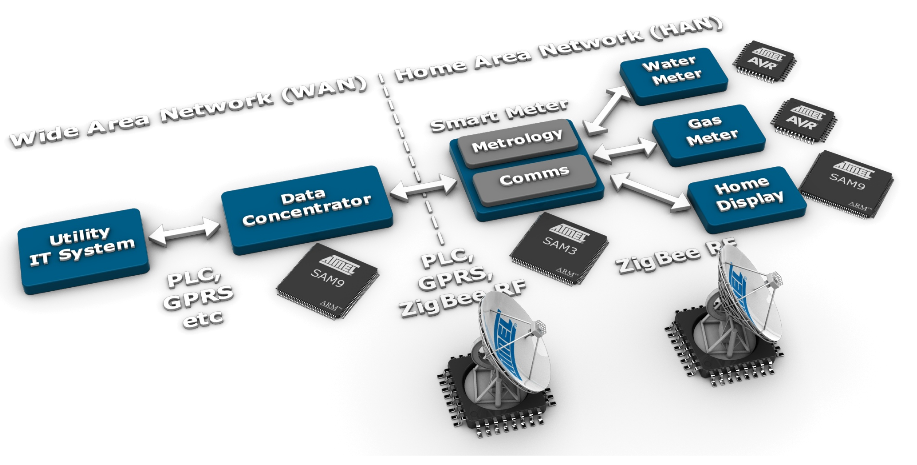The Serial ATA International Organization (Sata-IO) announced the Universal Storage Module (USM) standard at CES 2011. This standard mainly defines mechanical characteristics and some electrical specs for hard drives so that they can be connected to devices (PC, laptops, tablets, televisions, media players, set-top boxes…) via a slot without the need to have an extra cable. This also allows a SATA harddisk to be used as a USB harddrive via a standard adapter. Later on this will also support other connection standards such as Firewire. The specifications will only support 2.5″ HDD, not the larger 3.5″. Those specifications are not publicly available yet (Target: 1H 2011) since they are still developing them. In the mean time you can check the FAQ (below) and have a look a the USM presentation slides. Seagate showcased their GoFlex design based on the USM specs where you can see the forum factor of the SATA […]
Top Ten Digital Signage Trends for 2011
As 2010 comes to a close, Digital Signage Today released their top 10 trends for 2011. Here’s a summary of those trends: Cross-media platform and technology integration: Digital signage systems and mobile devices such as smartphones and tablets will communicate more and more be it through QR Code, Near Field Communication (NFC), smartphone gestures, etc… Content will continue to be at or near the top of the list: More and more companies are involved in content creation for digital signage / digital out of hone (DOOH) and more diverse and complex content formats will be available. M & A and investment – The big shakeout of 2011: Expect more acquisitions that in 2010. Even larger amounts of ad dollars will migrate to DOOH: Digital Signage Ad growth spending will carry on, after a 14.8% growth in 2010. Experience, engagement and interaction: Instead of simply being an ad to promote a […]
Digital Signage TCO Calculator
AMX has recently released a Total Cost of Ownership Calculator for digital signage comparing two different setups by taking into account the following parameters: Digital Signage Requirements: Number of Players Hours per Day Days per Week Weeks per Year Expected life in years US State Deployed (For electricity rates) Cost of Development for 2 products: Media Player Cost Per Unit Initial Software Cost Initial Subscription Fee Monthly Subscription Fee Energy Efficiency: Player Power Consumption in Watts Hardware Design: Type of storage: Solid State / Hard Disk Fan: With or Without The result of the calculation will show you the total cost in a graph, with the lifetime electricity cost, total subscription cost, total software cost and total player cost. If you purchased the players and plan to manage the devices by yourself, you won’t have to pay any subscription fees. However, you’ll still have to consider the maintenance costs. In […]
Embedded Systems Hardware & Software Trends for 2011
VDC Research – a US company specialized in technology market intelligence – recently released two reports about embedded systems trends for 2011. The first report focuses on hardware and the second on software. The first report entitled “Top 10 trends for the embedded hardware and systems market in 2011” listed the following trends: COMs gain traction as time-to-market accelerators for OEMs By combining COM express modules with off-the-shelf COMs, suppliers are able to offer several different configurations of CPU boards and leverage COMs’ interchangeable characteristics. CPU vendors can thus offer a fairly wide range of boards without incurring high design and inventory carrying costs. PC/104 module family under pressure Although VDC data projects the PC/104 family will experience a single-digit rebound from the low points of the recent recession, vendors will have to commit resources to develop newer strategies in order for this technology to remain viable. Otherwise, the recovery […]
Software Code Review Study and Best Practices
Many companies perform software development without code reviews – the systematic examination of source code intended to find and fix mistakes overlooked by the original developer – or at least without formal reviews. I’ve recently come across The Value and Importance of Code Review white paper from Klocwork who commissioned an independent company to survey IT professional. This paper shows code review practices have not changed much over the years even though software development have dramatically evolved. Here are the key findings of the study: Code reviews are valuable, but approaches tend not to be formal. Modern development is increasingly complex, and code reviews are not keeping pace. (i.e. Code reviews are low priority tasks) Code reviews don’t always include the right people. (e.g. Architecture and QA Team are left out, only only software engineer are part of the review) Tools don’t play a significant role in reviews. (e.g. code […]
Detecting Code Duplicates in C/C++ with CCFinderX
Over time, as your source code repository and software team(s) grow, you may have more and more code that just does the same thing. This is obviously not desirable since several persons work on code doing the same thing, so you just pay twice for the cost for development and debugging. To avoid this issue, proper team communication and management must be in place (e.g. discourage copy/paste of source code, use a common source control repository..). However, it might be difficult to always detect where the code duplicates are. Luckily, code duplication analysis tools such as CCFinderX are here to help. As described on CCFinderX website: CCFinderX is a code-clone detector, which detects code clones (duplicated code fragments) from source files written in Java, C/C++, COBOL, VB, C#. CCFinderX is a major version up of CCFinder, and it has been totally re-designed and re-implemented from scratch. Its new design and […]
In-Home Displays for Smart Grid – Atmel – Mentor Embedded
I’ve just attended a webinar organized by Mentor Graphics entitled “In-Home Displays: Enabling Smart Grid into every home” with Atmel and Mentor Embedded. This webinar is now available on-demand at http://go.mentor.com/hAz8 This webinar is divided into 2 parts: Frederic Gaillard – Product Marketing Manager at ATMEL – gave an overview of Smart Grid and its different components and presented Atmel Solutions: MCU/MPU, wireless chips (Zigbee/Wi-Fi) and touch screen chipset. Gordon Cameron – Business Development Manager at Mentor Embedded – focused on the difficulties in developing a user interface for In-Home Displays within a short time frame and how Mentor Embedded UI design solution Inflexion could help greatly reduce the development schedule. There was no external files for this webinar, so I created 2 PDF with the most relevant slides for your reference: Atmel Smart Grid and In-Home Displays Mentor Embedded In-Home Displays UI Development Tools Frederic Gaillard shortly explained the […]
Sharing Thunderbird Emails between Windows and Linux
I’ve used Windows XP with Linux in a virtual machine (VirtualBox) for a while. But since this proved to be very slow, I’ve just installed Ubuntu (dual boot mode) in my PC. However, I wanted to be able to use the same Thunderbird profile in both OS. So here’s how to do: After installating Ubuntu, open a terminal window and: 1. Install Thunderbird: sudo apt-get install thunderbird 2. Start Thunderbird in Profile Manager mode: thunderbird -profilemanager Then create a new profile (any name) and click on “Change folder” and point it to your Thunderbird profile in Windows (Something like: Documents and Settings\username\Application Data\Thunderbird\Profiles\abcdef.default). You may delete the default profile and start Thunderbird. You should then see all your emails and RSS feeds in Thunderbird and receive and send emails in Linux as you used to in Windows XP. Jean-Luc Aufranc (CNXSoft)Jean-Luc started CNX Software in 2010 as a part-time endeavor, […]









